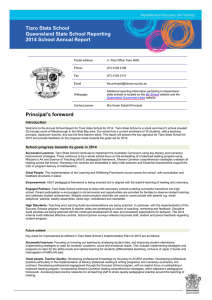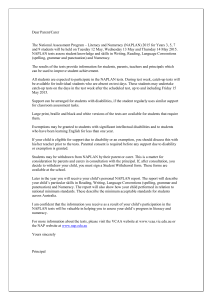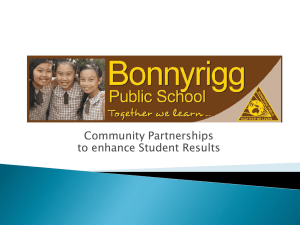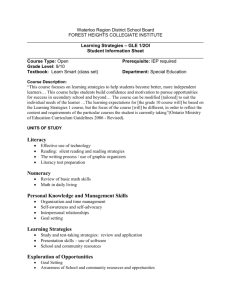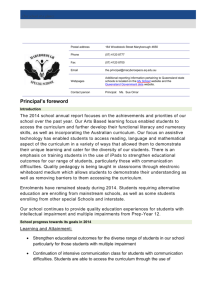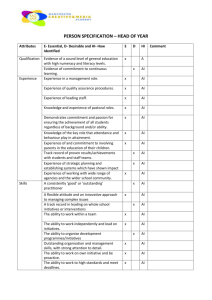Woongarra School Annual Report 2013
advertisement
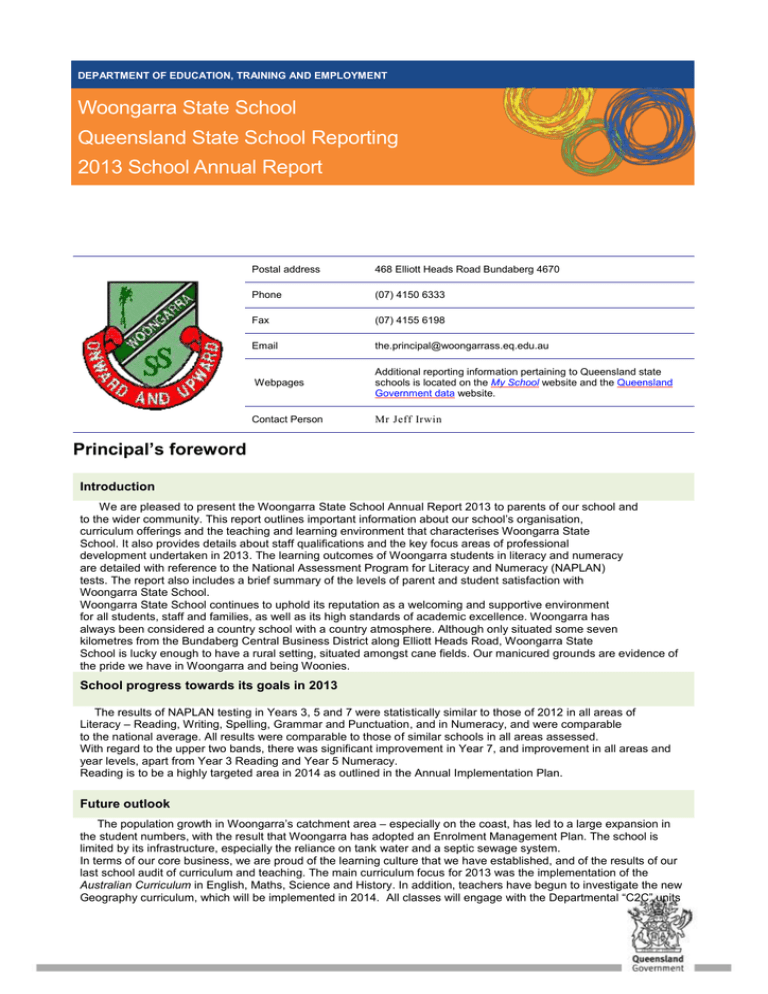
T DEPARTMENT OF EDUCATION, TRAINING AND EMPLOYMENT Woongarra State School Queensland State School Reporting 2013 School Annual Report YPEOVER TO INSERT SCHOOL NAME Postal address 468 Elliott Heads Road Bundaberg 4670 Phone (07) 4150 6333 Fax (07) 4155 6198 Email the.principal@woongarrass.eq.edu.au Webpages Additional reporting information pertaining to Queensland state schools is located on the My School website and the Queensland Government data website. Contact Person Mr Jeff Irwin Principal’s foreword Introduction We are pleased to present the Woongarra State School Annual Report 2013 to parents of our school and to the wider community. This report outlines important information about our school’s organisation, curriculum offerings and the teaching and learning environment that characterises Woongarra State School. It also provides details about staff qualifications and the key focus areas of professional development undertaken in 2013. The learning outcomes of Woongarra students in literacy and numeracy are detailed with reference to the National Assessment Program for Literacy and Numeracy (NAPLAN) tests. The report also includes a brief summary of the levels of parent and student satisfaction with Woongarra State School. Woongarra State School continues to uphold its reputation as a welcoming and supportive environment for all students, staff and families, as well as its high standards of academic excellence. Woongarra has always been considered a country school with a country atmosphere. Although only situated some seven kilometres from the Bundaberg Central Business District along Elliott Heads Road, Woongarra State School is lucky enough to have a rural setting, situated amongst cane fields. Our manicured grounds are evidence of the pride we have in Woongarra and being Woonies. School progress towards its goals in 2013 The results of NAPLAN testing in Years 3, 5 and 7 were statistically similar to those of 2012 in all areas of Literacy – Reading, Writing, Spelling, Grammar and Punctuation, and in Numeracy, and were comparable to the national average. All results were comparable to those of similar schools in all areas assessed. With regard to the upper two bands, there was significant improvement in Year 7, and improvement in all areas and year levels, apart from Year 3 Reading and Year 5 Numeracy. Reading is to be a highly targeted area in 2014 as outlined in the Annual Implementation Plan. Future outlook The population growth in Woongarra’s catchment area – especially on the coast, has led to a large expansion in the student numbers, with the result that Woongarra has adopted an Enrolment Management Plan. The school is limited by its infrastructure, especially the reliance on tank water and a septic sewage system. In terms of our core business, we are proud of the learning culture that we have established, and of the results of our last school audit of curriculum and teaching. The main curriculum focus for 2013 was the implementation of the Australian Curriculum in English, Maths, Science and History. In addition, teachers have begun to investigate the new Geography curriculum, which will be implemented in 2014. All classes will engage with the Departmental “C2C” units DEPARTMENT OF EDUCATION, TRAINING AND EMPLOYMENT Queensland State School Reporting 2012 School Annual Report of work as they are provided, and participate in cluster moderation of student work. A process of creating “A” exemplars and explicitly forefronting assessment will add to the alignment of planning, assessment and reporting. While Literacy and Numeracy were a particular emphasis in 2013, informed by student performance in both NAPLAN and school-based assessment, the focus has been narrowed to really concentrate on reading strategies. In particular, on higher order skills such as inferring, predicting, sequencing, comparing and contrasting. The appointment of a Literacy Coach, through the National Partnerships program, has been of significant benefit, both to improving student learning, and to the depth and quality of pedagogical practice. The continued funding of this position has ensured the strong focus on Reading in 2013, as indicated in the Annual Implementation Plan 2013. The emphasis on collaborative planning and moderation was further strengthened, and staff engaged in goal setting and coaching feedback to both reflect upon, and improve, teaching practice. Some of the priorities identified in the Annual Implementation Plan 2013 are, in brief, as follows: Literacy Priority Implement a Framework for the teaching of Reading; Develop a shared understanding and pedagogical practice of the 5 reading procedures i.e.: Reading Aloud (students); 2. Modelled reading; 3. Shared Reading; 4. Guided Reading; and 5. Independent reading. Embed comprehension strategies into the reading procedures, and use these reading procedures as a focus for Instructional Leadership to build teacher capacity through observation and feedback. Interpret reading data (e.g. NAPLAN, Pat R, Benchmarks) to develop student reading goals. Ensure early processes are in place to identify possible U2B students (commencing in Prep). Numeracy Priority Develop introductory routines to lessons that address key aspects of student needs with regard to Number, as identified through NAPLAN and internal data sources. Build on teachers’ prior professional development experience with First Steps in Mathematics. Share pedagogical expertise of Maths teachers at Kepnock SHS, for which Woongarra is a feeder school. Ensure a range and balance of assessment tools are being used (diagnostic, formative and summative) to support quality teaching, assessment and reporting. Art and Science Of Teaching Develop and implement an overarching Curriculum Framework based on ASOT. Investigate and begin to implement questions 1 and 6 of the ASOT framework: (1.What will I do to establish and communicate learning goals, track student progress and celebrate success? 6. What will I do to establish and maintain classroom rules and procedures?). Engage in professional development days focusing on the implementation of ASOT. Upper Two Bands Develop targeted strategies to maintain and increase student numbers in the U2Bs from Years 3 through to Year 7 in Literacy and Numeracy. Year 7 Move to Secondary School Liaise with feeder Secondary Schools; Develop protocols around leadership arrangements re 2014 (School Leaders, House Leaders, camps, assemblies, graduation and other ceremonies); Develop a communication strategy with community regarding relevant changes; Commence the development of strategies concerning staffing and resource allocations; Parent and Community Engagement Strategy. Our school at a glance School Profile Coeducational or single sex: Coeducational Year levels offered in 2013: Prep Year - Year 7 Total student enrolments for this school: Enrolment Continuity Total Girls (Feb – Nov) Boys 2011 470 234 236 94% 2012 478 238 240 95% 2013 483 237 246 94% Student counts are based on the Census (August) enrolment collection. Characteristics of the student body: Woongarra enjoys a fairly stable enrolment pattern with transience not being a problem. Enrolments have been steadily increasing to the point that the development of a school management plan to limit enrolments became necessary. The school can safely contain a maximum enrolment of about 520 students. Students are predominately from supportive families, some of whom are of Indigenous, European or Asian ethnicity . Average Class sizes Average Class Size 2011 2012 2013 Prep – Year 3 22 22 21 Year 4 – Year 7 Primary 27 23 21 Phase Year 7 Secondary – Year 10 Year 11 – Year 12 School Disciplinary Absences Note that the SDA figures below count those students recommended for an SDA, and not just the actual SDA. Count of Incidents Disciplinary Absences 2011 2012 2013 Short Suspensions - 1 to 5 days 2 3 16 Long Suspensions - 6 to 20 days 0 0 0 Exclusions 0 0 0 Cancellations of Enrolment 0 0 0 Our school at a glance Curriculum offerings Our distinctive curriculum offerings Instrumental Music – Brass, Woodwind, Percussion and Strings; Junior and Senior Choirs - Bundy In Bloom, Eisteddfod performances; Interschool sport; Athletics, including cross-country; Camps (Years 5 and 7); Robotics; Woongarra has been a “Reef Guardian” School since August 2004. Extra curricula activities Weekly lunchtimes Games Room run by GO & Chaplain; Book Week activities; Author/Illustrator visits; Life Education; Premier’s Reading Challenge; ANZAC Day ceremony; Human Relationships Education for Year 6 students (provided by Family Planning Queensland); Starlab “Cosmodome” visit. How Information and Communication Technologies are used to assist learning Woongarra has two computer laboratories which are in constant use. Computers are regarded as an essential tool for learning and are integrated into many aspects of the curriculum. They are frequently used as a vehicle for the assessment of student work. Specialized lessons are offered to Years 1-7 with all classes working towards appropriate levels of efficiency in skills built sequentially through the years. The robotics program at Woongarra has continued successfully in Year 7 and extended to Year 6. Interactive whiteboards, including those purchased through the National School Pride project, enhanced the potential for engaging students with ICT programs and rejuvenated pedagogical practice throughout the school. With the introduction of C2C units of work, this technology has become mandatory from Prep to Year 7. Teachers all used their government-issued laptops for planning, assessment and reporting. The transition to One School, the state-wide database, also simplifies record-keeping, including behaviour management data. The introduction of C2C online learning has resulted not only in engaging students in interactive online learning, but also in up skilling teaching staff in the integration of ICT into their daily routines. Innovations have included the use of digital technology such as bloggies, iPads and iPod touches, and programs such as Photostory, Edstudio, Mindstorms, Audacity and Easi-speaks to record and edit some aspects of student work. The “blue room” located in the resource centre provides an excellent venue for filming. Social climate As indicated by both our parent and staff opinion surveys, Woongarra has a highly supportive parent group, and sits within a community that, while growing, remains fairly consistent in terms of values relating to, and expectations of, schooling. Teachers and ancillary personnel form a supportive and cheerful staff with solidarity ensured through open Our school at a glance communication and regular professional and social events. There are many occasions when staff gives selflessly of their time outside school hours to celebrate student achievements or to take part in camping programs and excursions. Students are encouraged to help each other, in particular, the Year 6/Prep Buddy Program highlights the way in which older children care for younger ones. Better Buddy awards are given regularly at assemblies. Behaviour management, while not an area of concern at Woongarra, is assisted by a consistent and forefronted approach, guided by the mantra of the “5 B’s”: Be Respectful; Be Responsible; Be Positive; Be Proud; and Be Tolerant. The 3 Step Plan is now implemented across the school (1. Tell them to “Stop it, I don’t like it! 2. Walk away. 3. Tell an adult) to particularly target bullying and other inappropriate behaviours. In 2011, one of our Year 7 School Leaders and one of our Music teachers collaborated to write our school song which incorporates the 5 B’s in its lyrics, and therefore helps the students to internalise the words. Hearing all the children singing the school song is quite an uplifting experience. To improve support for students, Woongarra maintains a Chaplain. She has proven a real asset to the school - engaging students who are outside the mainstream, assisting the Guidance Officer with establishing a lunchtime activities program, helping with our Friday morning breakfasts (provided through the Christian Heritage Centre), and providing a sympathetic ear for students and parents who choose to access her time. Parent, student and staff satisfaction with the school As indicated by our parent opinion survey, Woongarra has a highly supportive parent group who are very satisfied with the education provided at the school. As indicated by our staff opinion survey, teachers and ancillary personnel form a supportive and cheerful staff who are very satisfied with, and supportive of, the school. As indicated by our student opinion survey, students are generally very satisfied with the education provided at the school. Our school at a glance Performance measure (Nationally agreed items shown*) Percentage of parents/caregivers who agree that: 2012 2013 their child is getting a good education at school (S2016) 93% 100% this is a good school (S2035) 100% 100% their child likes being at this school* (S2001) 100% 100% their child feels safe at this school* (S2002) 100% 100% their child's learning needs are being met at this school* (S2003) 93% 98% their child is making good progress at this school* (S2004) 97% 98% 100% 95% teachers at this school provide their child with useful feedback about his or her school work* (S2006) 93% 98% teachers at this school motivate their child to learn* (S2007) 93% 98% teachers at this school treat students fairly* (S2008) 97% 100% they can talk to their child's teachers about their concerns* (S2009) 100% 98% this school works with them to support their child's learning* (S2010) 93% 98% this school takes parents' opinions seriously* (S2011) 97% 98% student behaviour is well managed at this school* (S2012) 97% 100% this school looks for ways to improve* (S2013) 100% 100% this school is well maintained* (S2014) 100% 100% 2012 2013 they are getting a good education at school (S2048) 100% 100% they like being at their school* (S2036) 100% 97% they feel safe at their school* (S2037) 99% 97% their teachers motivate them to learn* (S2038) 100% 100% their teachers expect them to do their best* (S2039) 100% 100% their teachers provide them with useful feedback about their school work* (S2040) 100% 100% teachers treat students fairly at their school* (S2041) 97% 97% they can talk to their teachers about their concerns* (S2042) 92% 96% their school takes students' opinions seriously* (S2043) 97% 99% student behaviour is well managed at their school* (S2044) 100% 92% their school looks for ways to improve* (S2045) 100% 100% their school is well maintained* (S2046) 100% 100% 96% 97% teachers at this school expect their child to do his or her best* (S2005) Performance measure (Nationally agreed items shown*) Percentage of students who agree that: their school gives them opportunities to do interesting things* (S2047) Our school at a glance Performance measure Percentage of school staff who agree that: 2013 they enjoy working at their school (S2069) 100% they feel that their school is a safe place in which to work (S2070) 98% they receive useful feedback about their work at their school (S2071) 95% students are encouraged to do their best at their school (S2072) 100% students are treated fairly at their school (S2073) 100% student behaviour is well managed at their school (S2074) 98% staff are well supported at their school (S2075) 95% their school takes staff opinions seriously (S2076) 98% their school looks for ways to improve (S2077) 98% their school is well maintained (S2078) their school gives them opportunities to do interesting things (S2079) * Nationally agreed student and parent/caregiver items were incorporated in the School Opinion Survey in 2012. # Percentage of respondents who Somewhat Agree, Agree or Strongly Agree with the statement. Due to a major redevelopment of the surveys (parent/caregiver and student in 2012; staff in 2013), comparisons with results from previous years are not recommended. DW = Data withheld to ensure confidentiality. 100% 98% Our school at a glance Involving parents in their child’s education The partnership with parents is regarded as a vital component of successful student learning at Woongarra, and we therefore create as many opportunities as possible to involve families in school life. Communication is transparent and frequent through not only the weekly newsletter, but also through faceto-face contact, regular class letters home, phone calls when necessary and of course regular reporting on students’ progress through school reports and formal interviews. Parent volunteers are always welcome and all classes avail themselves of parents’ talents and assistance throughout the year. Several parents have undertaken the TAFE Certificate 3 for Teacher Aides and are supported by specific teachers. Our Parents and Citizens’ meetings are very well-attended, our tuckshop has a secure supply of parent helpers and we have received positive feedback through the Parent Opinion Survey. This all attests to the welcome the parent body appreciates at Woongarra. A number of events throughout the school year have become traditions at Woongarra strongly supported by families. The school ANZAC Day commemoration service and the Coastal Sports afternoon in preparation for district sports (which Woongarra hosts) are just some of the traditions of which we are very proud. Involvement of parents in these occasions frequently leads to their increased participation in the learning/teaching aspects of school. . Reducing the school’s environmental footprint Data is sourced from school's annual utilities return and is reliant on the accuracy of these returns. The amount of use of electricity would have been expected to increase following the air-conditioning of all work spaces, as well as all classrooms now using interactive whiteboards on a daily basis. We are proud of our smaller environmental footprint! Staff and students have been coached in how to manage the use of electrical appliances (e.g. turning off lights, computers & air conditioning) for energy efficiency, which probably explains the reduction kWh - despite the sheer amount and usage of electrical resources in this technological age. Care with water use has always been a focus, as the school is on tank and bore water, not mains supply. Environmental footprint indicators Electricity kWh Water kL 2010-2011 118,004 0 2011-2012 122,900 0 2012-2013 64,503 0 The consumption data is sourced from the validated utilities expenditure return which the school submits at the end of each financial year. The data provides an indication of the consumption trend in each of the utility categories which impact on the schools environmental footprint. Our staff profile Staff composition, including Indigenous staff 2013 Workforce Composition Teaching Staff * Non-teaching Staff Indigenous Staff Headcounts 41 20 <5 Full-time equivalents 32 11 <5 Qualifications of all teachers Highest level of attainment Number of Teaching Staff * Certificate 0 Diploma 1 Advanced Diploma 0 40 36 35 30 25 20 15 Bachelor Degree Graduate Diploma etc. 36 1 10 5 0 1 0 0 Masters 2 Doctorate 0 Total 40 * Teaching Staff includes School Leaders ** Graduate Diploma etc. includes Graduate Diploma, Bachelor Honours Degree, and Graduate Certificate 1 2 0 Our staff profile Expenditure on and teacher participation in professional development The total funds expended on teacher professional development in 2013 were $ 10468.72 The major professional development initiatives were as follows: Poverty training Sheena Cameron – focus on reading strategies ASOT training Special Education HPE conference Music conference Dyslexia workshop The proportion of the teaching staff involved in professional development activities during 2013 was 100%. Code of Conduct; Child Safety; Recording & analyzing data; Curriculum implementation, especially History; Moderation strategies; Behaviour management; Cohort meetings; ICT strategies. The proportion of the teaching staff involved in professional development activities during 2013 was 100 %. Average staff attendance 2011 2012 2013 Staff attendance for permanent and temporary staff and school leaders. 97% 97% 97% Proportion of staff retained from the previous school year From the end of the previous school year, 97% of staff was retained by the school for the entire 2013 school year. School income broken down by funding source School income broken down by funding source is available via the My School website at http://www.myschool.edu.au/ To access our income details, click on the My School link above. You will then be taken to the My School website with the following ‘Find a school’ text box. Our staff profile Where it says ‘Search by school name’, type in the name of the school you wish to view, and select <GO>. Read and follow the instructions on the next screen; you will be asked to accept the Terms of Use and Privacy Policy before being given access to the school’s My School entry web page. School financial information is available by selecting ‘School finances’ in the menu box in the top left corner of the school’s entry web page. If you are unable to access the internet, please contact the school for a paper copy of income by funding source. Performance of our students Key student outcomes e Student attendance 2011 2012 2013 The overall attendance rate for the students at this school (shown as a percentage). 93% 93% 94% The overall attendance rate in 2013 for all Queensland state Primary schools was 92%. Student attendance rate for each year level (shown as a percentage) Year 1 Year 2 Year 3 Year 4 Year 5 Year 6 Year 7 2011 93% 93% 93% 92% 93% 92% 94% 2012 93% 93% 94% 94% 91% 93% 93% 2013 94% 93% 94% 95% 94% 92% 95% Year 8 Year 9 Year 10 Year 11 Year 12 DW = Data withheld to ensure confidentiality. Student Attendance Distribution The proportions of students by attendance range. Attendance Rate: 0% to <85% * 2013 10 9 2012 10 11 2011 11 0% 85% to <90% 90% to <95% 22 59 29 15 20% 95% to 100% 50 31 40% 43 60% 80% 100% Proportion of Students * The method for calculating attendance changed in 2013 – care should be taken when comparing data from 2013 to that of previous years. Performance of our students Description of how non-attendance is managed by the school Non-attendance is managed in state schools in line with the DET policies, SMS-PR-029: Managing Student Absences and SMS-PR-036: Roll Marking in State Schools, which outline processes for managing and recording student attendance and absenteeism. Rolls are marked at the start of each morning and immediately after lunch. Rolls are sent to the Office every Friday and entered on One School. Absences are recorded as illness (I), holidays (H), sport (S), other (O), unauthorised (J) or unexplained (U). With the introduction of a new phone system the school now has a dedicated “absence line” for parents to report their children’s illnesses or other reasons for absence. Caregivers are required to sign children in and out for late arrivals and/or early leaving in a register in the school office. In the case of unexplained absences contact is made with the caregivers, either by the class teacher or the office personnel. Should long-term absences occur and contact attempted by the class teacher or office personnel unsuccessful, the Deputy Principal or Principal will attempt contact with the family. Once reasons are established for the absence, appropriate action is taken to ensure that the children concerned are able to attend school regularly. If there are issues which appear to be related to the care/safety of the children in the home environment, appropriate agencies (e.g. Department of Child Safety) are approached. National Assessment Program – Literacy and Numeracy (NAPLAN) results – our reading, writing, spelling, grammar and punctuation, and numeracy results for the Years 3, 5, 7 and 9. Our reading, writing, spelling, grammar and punctuation, and numeracy results for the Years 3, 5, 7 and 9 are available via the My School website at http://www.myschool.edu.au/. To access our NAPLAN results, click on the My School link above. You will then be taken to the My School website with the following ‘Find a school’ text box. Where it says ‘Search by school name’, type in the name of the school whose NAPLAN results you wish to view, and select <GO>. Read and follow the instructions on the next screen; you will be asked to accept the Terms of Use and Privacy Policy before being able to access NAPLAN data. If you are unable to access the internet, please contact the school for a paper copy of our school’s NAPLAN results. Achievement – Closing the Gap According to the 2013 NAPLAN results in Reading and Numeracy, the majority of Indigenous students at Woongarra demonstrated that they met or exceeded the system aspiration for those curriculum areas. Attendance of Indigenous students is not a statistically significant problem, with an average attendance rate of 87.9%. Indigenous students with difficulties in Literacy received extra in-school tuition from a teacher employed for 6 hours per week. Performance of our students Indigenous parents are very supportive at Woongarra, both in terms of their individual children’s learning, but also with promoting relevant Indigenous issues with staff and students.
